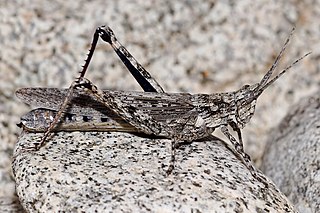
Acrididae, commonly called short-horned grasshoppers, are the predominant family of grasshoppers, comprising some 10,000 of the 11,000 species of the entire suborder Caelifera. The Acrididae are best known because all locusts are of the Acrididae. The subfamily Oedipodinae is sometimes classified as a distinct family Oedipodidae in the superfamily Acridoidea. Acrididae grasshoppers are characterized by relatively short and stout antennae, and tympana on the side of the first abdominal segment.

Bandwings, or band-winged grasshoppers, are the subfamily Oedipodinae of grasshoppers classified under the family Acrididae. They have a worldwide distribution and were originally elevated to full family status as the Oedipodidae. Many species primarily inhabit xeric weedy fields, and some are considered to be important locusts:

The Melanoplinae are a subfamily of grasshoppers in the family Acrididae. They are distributed across the Holarctic and Neotropical realms. They are one of the two largest subfamilies in the Acrididae. As of 2001 the Melanoplinae contained over 800 species in over 100 genera, with more species being described continuously.

Trimerotropis is a genus of band-winged grasshoppers in the family Acrididae. There are at least 50 described species in Trimerotropis.
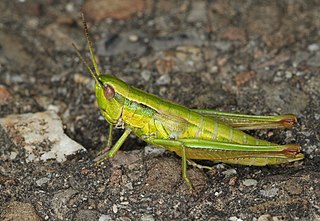
Gomphocerinae, sometimes called "slant-faced grasshoppers", are a subfamily of grasshoppers found on every continent but Antarctica and Australia.

Acrida is a genus of grasshoppers in the family Acrididae. The genus contains around 40 species which are found in Africa, Europe, Asia, North America, Hawaii, and Australia. Insects of this genus are omnivorous and a well-known pest of many agricultural crops.
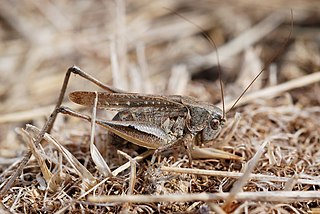
Platycleis is a genus of bush crickets described by Fieber in 1853, belonging to the subfamily Tettigoniinae. The species of this genus are present in Europe, North Africa and temperate Asia.

Barbitistes is a genus of bush crickets in the subfamily Phaneropterinae.

Podisma is a genus of 'short-horned grasshoppers' belonging to the family Acrididae and the subfamily Melanoplinae.

Podismini is a tribe of "spur-throated grasshoppers" in the family Acrididae. This tribe is unlike others in the subfamily Melanoplinae in that genera are found throughout the northern hemisphere, with a substantial number occurring outside the Americas.
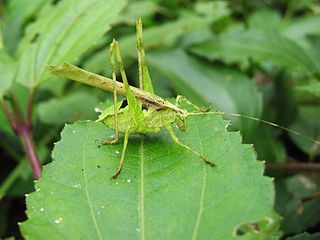
Insara, commonly known as western bush katydids, is a genus of katydids in the family Tettigoniidae.

Nocarodes is a genus of grasshoppers in the family Pamphagidae. There are at least 20 described species in Nocarodes, found in southeastern Europe and southwestern Asia.

Huastecacris is a genus of spur-throated grasshoppers in the family Acrididae. There are at least four described species in Huastecacris, found in Mexico.
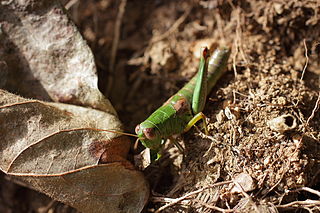
Parapodisma is a genus of spur-throated grasshoppers in the family Acrididae. There are about 12 described species in Parapodisma, found in Japan, China, and South Korea.
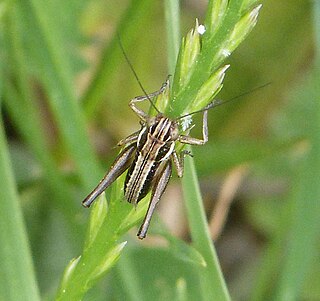
Pterolepis is a genus of bush crickets in the subfamily Tettigoniinae and tribe Platycleidini erected by Jules Pierre Rambur in 1838. The known distribution is from North Africa and the Iberian peninsula.
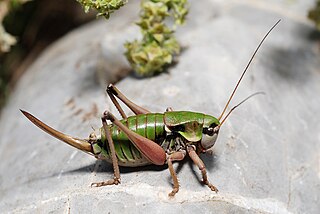
Anonconotus is a genus of Palaearctic bush crickets in the tribe Platycleidini, erected by L. Camerano in 1878. Species may be called "Alpine bush crickets" and can be found in mainland western Europe, with most records from France through to Austria and Italy.
Duroniella is a genus of Palaearctic grasshoppers in the tribe Phlaeobini and now placed in genus group Duronia, erected by Ignacio Bolívar in 1908. Distribution records include: the North and Horn of Africa, Sardinia, Greece and the Balkans, through to central Asia.
Eremippus is a genus of Palaearctic grasshoppers in the tribe Dociostaurini, erected by Boris Uvarov in 1926. Species are recorded from eastern Europe and central Asia through to eastern China.
Capraiuscola is a monotypic genus of Palaearctic grasshoppers in the tribe Podismini and subtribe Miramellina, erected by A. Galvagni in 1986. The recorded distribution for this grasshopper is in eastern Europe: from Romania up to Poland.















